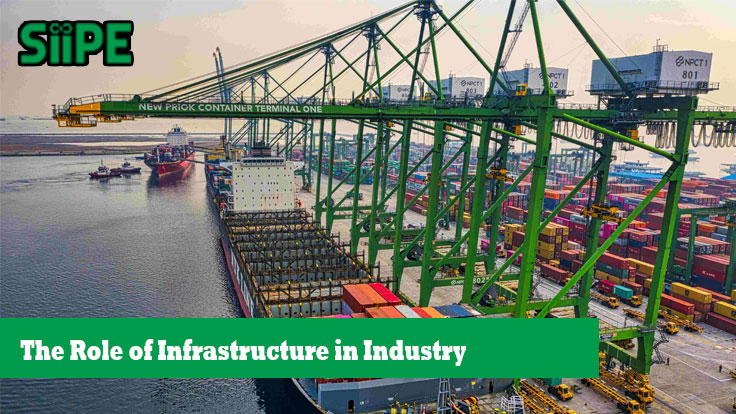1. The Pillars of Industrial Infrastructure
1.1 Transportation Networks
Transportation infrastructure is critical for industrial operations, facilitating the movement of raw materials, products, and personnel. This category includes roads, railways, ports, and airports. Efficient transportation networks reduce costs, increase reliability, and enable industries to reach global markets. For instance, ports like those in Singapore and Rotterdam serve as vital hubs for international trade, impacting global supply chains.
1.2 Energy Systems
Energy infrastructure—comprising electricity grids, gas pipelines, and renewable energy sources—is essential for powering industrial activities. Reliable energy supply is crucial for maintaining production schedules and avoiding costly downtimes. Industries are increasingly turning to renewable energy sources such as wind, solar, and hydro to mitigate environmental impacts and enhance sustainability.
1.3 Telecommunications
Telecommunications infrastructure supports the digital needs of modern industries. High-speed internet, data centers, and communication networks enable real-time data transfer, cloud computing, and digital collaboration. As industries adopt Industry 4.0 technologies, including IoT (Internet of Things) and AI (Artificial Intelligence), robust telecommunications infrastructure becomes even more vital.
1.4 Water and Waste Management
Industries rely heavily on water for production processes, cooling systems, and sanitation. Effective water management infrastructure ensures the availability and quality of water while minimizing environmental impact. Similarly, waste management systems handle industrial byproducts, recycling, and disposal, which are crucial for maintaining environmental standards and operational efficiency.
2. Economic Impact of Infrastructure
2.1 Boosting Industrial Productivity
Well-developed infrastructure enhances industrial productivity by reducing transportation costs, minimizing delays, and improving resource efficiency. For example, the development of high-speed rail systems can dramatically cut transportation times, which directly benefits industries by streamlining supply chains and reducing operational costs.
2.2 Attracting Investment
High-quality infrastructure is a key factor in attracting both domestic and foreign investment. Industries are more likely to set up operations in regions with reliable infrastructure, as it provides a stable and predictable environment for business activities. Countries with well-developed infrastructure often enjoy higher levels of economic growth and competitiveness.
2.3 Enhancing Global Competitiveness
Infrastructure improvements can boost a country’s global competitiveness by lowering trade costs and improving access to international markets. For example, the expansion of the Panama Canal has significantly increased the capacity for global shipping, benefiting industries worldwide by facilitating more efficient trade routes.
3. Challenges Facing Industrial Infrastructure
3.1 Aging Infrastructure
One of the major challenges facing infrastructure today is aging. Many industrial infrastructures, particularly in developed countries, were built decades ago and are now in need of modernization. Upgrading or replacing outdated infrastructure requires substantial investment and careful planning to avoid disrupting industrial operations.
3.2 Sustainability Concerns
As industries grow, so does their environmental footprint. Sustainable infrastructure development is crucial to addressing issues such as climate change and resource depletion. Industries must focus on creating green infrastructure that minimizes environmental impact, such as energy-efficient buildings, renewable energy systems, and waste reduction technologies.
3.3 Technological Integration
The integration of advanced technologies into existing infrastructure poses both opportunities and challenges. While technologies like IoT and AI can optimize infrastructure performance and maintenance, their implementation requires significant investment and technical expertise. Additionally, the rapid pace of technological advancement necessitates continuous upgrades to keep infrastructure relevant and effective.
3.4 Regulatory and Policy Issues
Infrastructure development is often influenced by regulatory and policy frameworks. Governments play a critical role in shaping infrastructure through policies related to funding, zoning, and environmental standards. Navigating these regulatory landscapes can be complex for industries, particularly when dealing with cross-border projects or multi-jurisdictional issues.
4. Future Trends in Industrial Infrastructure
4.1 Smart Infrastructure
The future of industrial infrastructure is leaning towards smart technologies that integrate sensors, data analytics, and automation. Smart grids, intelligent transportation systems, and automated waste management are examples of how technology can enhance infrastructure efficiency and adaptability. These advancements promise to make infrastructure more responsive to real-time conditions and operational needs.
4.2 Sustainable and Resilient Design
Sustainability and resilience are becoming central themes in infrastructure development. Future infrastructure projects are likely to prioritize eco-friendly materials, energy efficiency, and climate resilience. For example, green buildings and infrastructure projects designed to withstand extreme weather conditions will become increasingly common as industries address environmental and climate-related challenges.
4.3 Decentralized Energy Systems
Decentralized energy systems, such as microgrids and local renewable energy sources, are gaining traction. These systems can provide industries with greater energy security and reduce dependence on large, centralized power plants. By integrating local energy solutions, industries can achieve greater sustainability and operational flexibility.
4.4 Advanced Materials and Construction Techniques
Innovations in materials science and construction techniques are paving the way for more durable and efficient infrastructure. Advanced materials, such as self-healing concrete and high-strength composites, promise to extend the lifespan of infrastructure and reduce maintenance costs. Additionally, construction methods like 3D printing and modular building are revolutionizing the way infrastructure projects are executed.
Infrastructure affects everything
Infrastructure plays a fundamental role in the functioning and growth of industries. It impacts everything from productivity and investment to environmental sustainability and global competitiveness. As industries continue to evolve, the demands on infrastructure will grow, necessitating innovative solutions and forward-thinking strategies. By addressing current challenges and embracing future trends, we can build a robust infrastructure that supports sustainable industrial development and drives economic progress.











